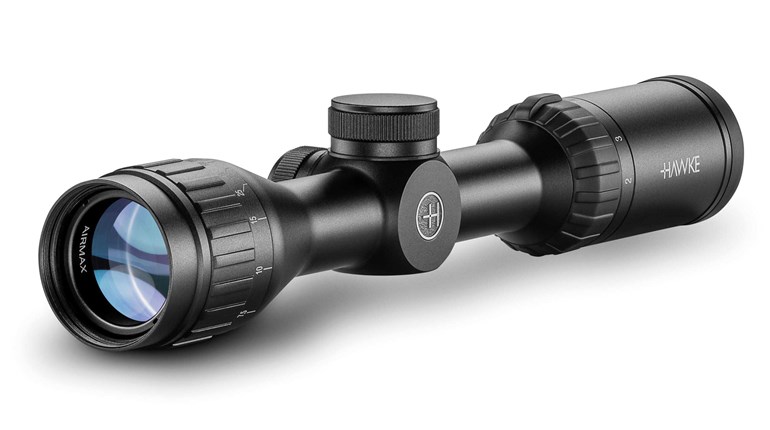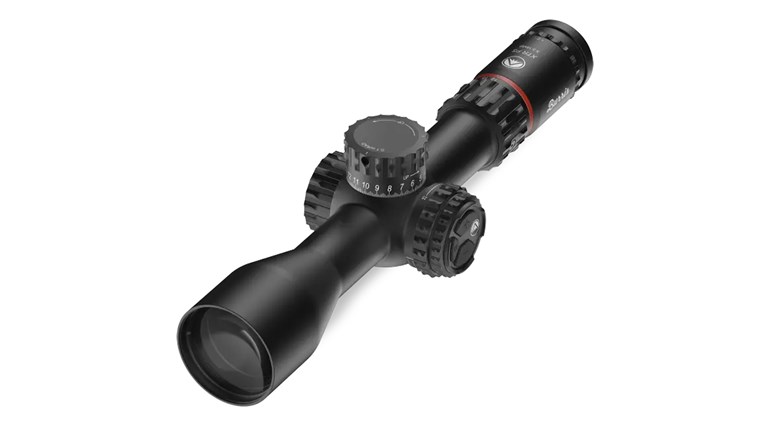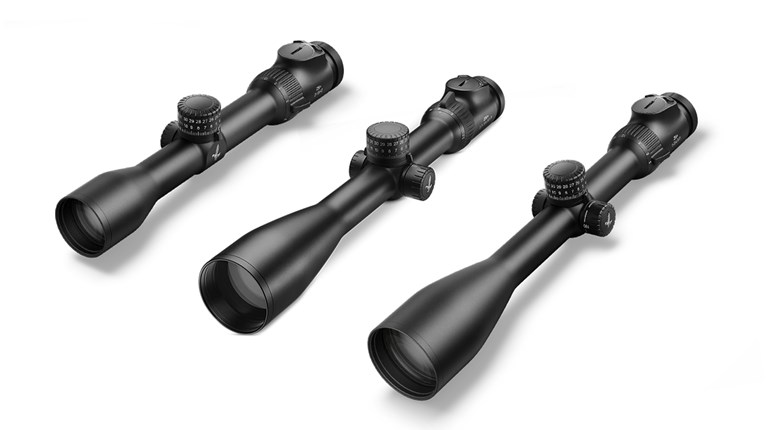
A trip to your local gun shop or gun show will affirm the unwavering popularity of rifles chambered in .223 Rem. Chances are, most will sport some form of red-dot sight. Although such optics foster rapid target acquisition and enable both eyes to remain open while engaging a target, they typically lack the precision accuracy of those with more traditional designs, due to the dot’s size and the absence of magnification.
 Measuring slightly more than 8 inches in length and weighing a mere 12.2 ounces, the Nikon P-223 3x32 mm is a compact and lightweight scope, adding little bulk while occupying not much more real estate than a red-dot. But unlike a red-dot, the P-223 doesn’t rely on illumination. Instead, this svelte optic combines fixed 3X magnification with the company’s Bullet Drop Compensating (BDC) Carbine recticle, which was developed specifically for the 55-grain .223 Rem./5.56 NATO round and features a 200-yard crosshair with corresponding hash marks at 400 and 600 yards. The pairing of low magnification combined with the easy-to-employ BDC recticle makes alternating between short- and intermediate-range targets the heart of the utilitarian, but versatile, optic. But, what does this mean for the shooter who prefers heavier bullets or engaging targets at distances beyond the predetermined ranges?
Measuring slightly more than 8 inches in length and weighing a mere 12.2 ounces, the Nikon P-223 3x32 mm is a compact and lightweight scope, adding little bulk while occupying not much more real estate than a red-dot. But unlike a red-dot, the P-223 doesn’t rely on illumination. Instead, this svelte optic combines fixed 3X magnification with the company’s Bullet Drop Compensating (BDC) Carbine recticle, which was developed specifically for the 55-grain .223 Rem./5.56 NATO round and features a 200-yard crosshair with corresponding hash marks at 400 and 600 yards. The pairing of low magnification combined with the easy-to-employ BDC recticle makes alternating between short- and intermediate-range targets the heart of the utilitarian, but versatile, optic. But, what does this mean for the shooter who prefers heavier bullets or engaging targets at distances beyond the predetermined ranges?
 Thanks to Nikon’s Spot On ballistic technology, matching the P-223 and recticle to your particular load is simply a matter of accessing Nikon’s website or the Spot On app, and selecting the data from the corresponding pull-down menus. The program gives you the accurate distance for the reference points in the recticle, based on the information you enter.
Thanks to Nikon’s Spot On ballistic technology, matching the P-223 and recticle to your particular load is simply a matter of accessing Nikon’s website or the Spot On app, and selecting the data from the corresponding pull-down menus. The program gives you the accurate distance for the reference points in the recticle, based on the information you enter.
For lead-slingers with novice Web-Fu skills—like me—the P-223 3x32 mm has target turrets (permitting you to dial in corrections and eliminate the guesswork of holdover) with .5-inch windage and elevation adjustments, an impressive 100 MOA of total adjustment and the added benefit of a return-to-zero capability. Simply lifting the turrets enables you to zero them out without moving the reticle, the latter of which aids in making on-the-fly adjustments.
 Along similar lines, a large eye box assists in quickly acquiring the correct hash mark. Upon initial inspection, I found the fully multicoated Nikon glass clear and, to my surprise, it boasts up to 98-percent light transmission, making it capable of use in low light. Best of all, the P-223’s 32 mm objective-lens diameter permits substantially more light to enter the tube than conventional red-dots or magnified scopes of similar size and power. Whether targets are close or distant, the scope provides crisp, clear images, thanks to its quick-focus eyepiece.
Along similar lines, a large eye box assists in quickly acquiring the correct hash mark. Upon initial inspection, I found the fully multicoated Nikon glass clear and, to my surprise, it boasts up to 98-percent light transmission, making it capable of use in low light. Best of all, the P-223’s 32 mm objective-lens diameter permits substantially more light to enter the tube than conventional red-dots or magnified scopes of similar size and power. Whether targets are close or distant, the scope provides crisp, clear images, thanks to its quick-focus eyepiece.
In testing, the Nikon P-223 3x32 mm proved rugged and reliable. Turret feedback was positive and repeatable while I proceeded to “shoot the box.” For those who religiously note their zero settings, I found the highly visible numeric values on the turrets to be confidence building as the distance to target increased.
 That is only part of this optic’s allure—the ability to rapidly transition between close and intermediate targets is where it truly shines. Regardless of whether targets are up close or several football fields away, the P-223 is capable of delivering precision hits when seconds count. Of course, such versatility also boosts the fun factor for the weekend plinker. Similarly, the ability to successfully shave seconds from dynamic 3-gun stages could usher in victory or help transform a run-of-the-mill AR into a makeshift predator-eradication tool. Yet, while the P-223’s design and features offer an obvious advantage in such applications, I was uncertain how effective its fixed 3X magnification would stack up—compared with a conventional red-dot optic—in a home-defense scenario.
That is only part of this optic’s allure—the ability to rapidly transition between close and intermediate targets is where it truly shines. Regardless of whether targets are up close or several football fields away, the P-223 is capable of delivering precision hits when seconds count. Of course, such versatility also boosts the fun factor for the weekend plinker. Similarly, the ability to successfully shave seconds from dynamic 3-gun stages could usher in victory or help transform a run-of-the-mill AR into a makeshift predator-eradication tool. Yet, while the P-223’s design and features offer an obvious advantage in such applications, I was uncertain how effective its fixed 3X magnification would stack up—compared with a conventional red-dot optic—in a home-defense scenario.
To find out, I mounted the P-223 on one of my short-barreled ARs and used a shot timer while firing a series of three, three-shot drills at a distance of 10 yards. In spite of the fixed 3X magnification, the large eye box helped me to find the aiming point quickly. While an illuminated recticle would be a welcome feature, I was able shoot a 2.5-inch group average in 1.66 seconds. Afterward, I replaced the P-223 with a red-dot and repeated the drill. To my surprise, it proved capable of 1.5-inch groups—despite having a dot greater than 3 MOA—but its lack of magnification contributed to a par time of 2.81 seconds. Does a difference of 1 inch matter at home-defense distances? Probably not, but what I find of greater concern is the extra time I needed to acquire the red-dot.
 You could shell out several hundred dollars to buy a red-dot optic, along with the almost equal added expense of a magnifier. Considering the Nikon P-223 3x32 mm is roughly the same size as that package, offers a greater degree of adaptability and costs less than $150, however, the thought of mounting anything else on your AR may suddenly lose its allure.
You could shell out several hundred dollars to buy a red-dot optic, along with the almost equal added expense of a magnifier. Considering the Nikon P-223 3x32 mm is roughly the same size as that package, offers a greater degree of adaptability and costs less than $150, however, the thought of mounting anything else on your AR may suddenly lose its allure.

At just 8 inches long, the P-223 3x32 mm takes up minimal real estate on a rail section.

Pairing a fast-focus eyepiece with a large eyebox enhances target acquisition when speed of engagement counts.
For lead-slingers with novice Web-Fu skills—like me—the P-223 3x32 mm has target turrets (permitting you to dial in corrections and eliminate the guesswork of holdover) with .5-inch windage and elevation adjustments, an impressive 100 MOA of total adjustment and the added benefit of a return-to-zero capability. Simply lifting the turrets enables you to zero them out without moving the reticle, the latter of which aids in making on-the-fly adjustments.

The author found dialing-in the P-223 to be hassle-free, thanks to its well-marked turrets that rotated with positive clicks.
In testing, the Nikon P-223 3x32 mm proved rugged and reliable. Turret feedback was positive and repeatable while I proceeded to “shoot the box.” For those who religiously note their zero settings, I found the highly visible numeric values on the turrets to be confidence building as the distance to target increased.

The P-223’s knurled target turrets promote easy windage and elevation adjustments in the field. Raising the turret caps frees them to be returned to the inscribed zero mark without moving the reticle, which makes it easy to keep track of further changes.
To find out, I mounted the P-223 on one of my short-barreled ARs and used a shot timer while firing a series of three, three-shot drills at a distance of 10 yards. In spite of the fixed 3X magnification, the large eye box helped me to find the aiming point quickly. While an illuminated recticle would be a welcome feature, I was able shoot a 2.5-inch group average in 1.66 seconds. Afterward, I replaced the P-223 with a red-dot and repeated the drill. To my surprise, it proved capable of 1.5-inch groups—despite having a dot greater than 3 MOA—but its lack of magnification contributed to a par time of 2.81 seconds. Does a difference of 1 inch matter at home-defense distances? Probably not, but what I find of greater concern is the extra time I needed to acquire the red-dot.

null



































